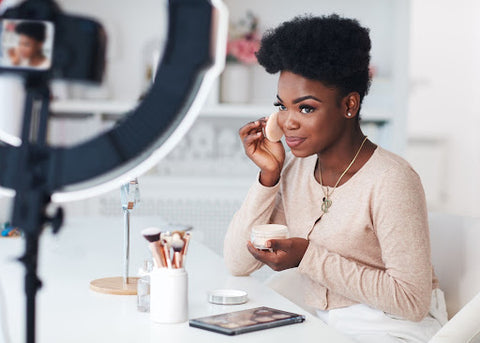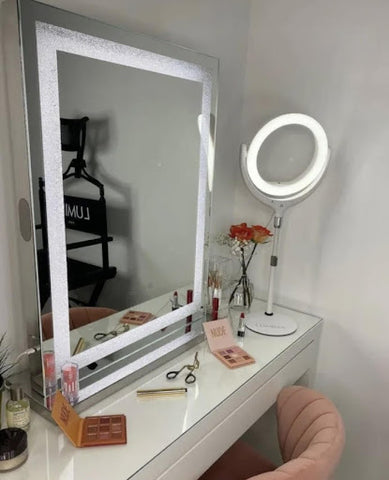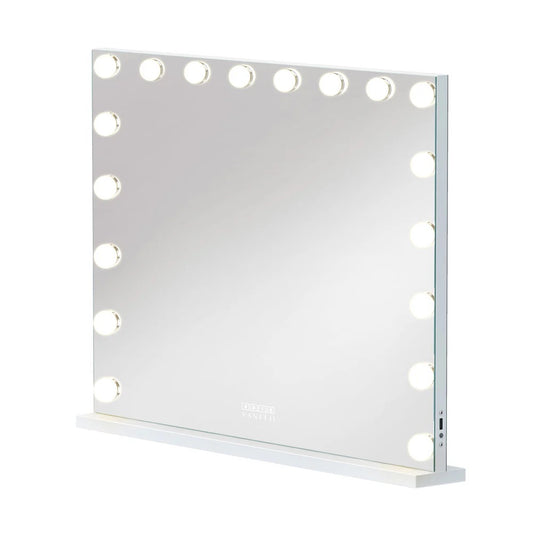White light is the best option for makeup application. Bulbs come in a range of colors, but despite the abundance of lighting choices available, it’s best to stick with the classic.
Light is the most significant factor in how we perceive color. The lighting you use for your makeup application can make or break the look you’re striving to create. The color light your vanity emits can completely change how you see yourself and how you apply makeup.
Let’s look at why white light is the best option for makeup application.
The Human Eye and Color

Photo by marinafrost on Shutterstock
When light travels into the eye and hits the retina located at the back of the eye, millions of light-sensitive cells called rods and cones send signals to the brain.
The human eye can only see objects that reflect light. The color we perceive depends on the wavelength the light reflects.
The cone cells in our eyes help us observe color, while our rod cells are stimulated by light at varying intensities. Cone cells are also in control of the shape, size, and brightness of the visual images we perceive.

Image by Lavreteva on Adobe Stock
While the pupil and iris work together to regulate the amount of light entering the eye, cone photoreceptors are adapting to the changes in light. The eye muscles relax in faint light and the pupil dilates. This dilation lets more light enter when exposed to bright light.
The eye muscles do the opposite in bright light and contract and constrict the pupil to reduce the amount of light entering. The rod and cone cell receptors enable our eyes to adapt to various light. The retina shifts functions between the rods and cones depending on the amount of light entering the eye.
Here’s a video that better explains how we see color.

Image from TED-Ed
Cones are responsible for our vision during the day and give us our color vision. Rods manage our night vision, are abundant, have one type of cell that doesn’t detect color, and have low resolution.
When a light is turned off, our eyes need time to adjust. The rod cells undergo bleaching from the light source that is gone. This undertaking is called dark adaptation and is slower than light adaptation because our rod receptors are more sensitive and 15X more abundant than cone cells.
Adaptation to dark light can take up to an hour.
Since cone cells regenerate much faster than rod cells, you can adapt to bright light faster.
The Purkinje Effect is an example of how light changes impact how we see color. This effect influences the brightness of colors we see when the light in our environment changes. When it’s dark, reds will appear darker, while blues will appear brighter.

Image by udaix on Shutterstock
Human eyes have a peak sensitivity of 555 nanometers during the day. This is the wavelength where human eyes can see the most color on the visible color spectrum.
Kelvins and Color Temperature
Photo by LadyRhino on Shutterstock
Kelvin is a unit of measurement used to obtain the color temperature of a light source.
This unit of measurement gives a description of how warm or cool a light source looks. Conventionally, yellow-red colors are deemed “warm” and blue-green colors are “cool.”
Cool colors range from 3600-6500K and warm colors are lower Kelvin at about 2700-3200K.
Ideally, 4800K to 5000K is recommended for makeup application. This is because it's not too warm or too cool and emits a peak wavelength close to 555 nanometers. This allows our eyes to see a fuller range of visible color.
Lumens and Artificial Light Sources

Photo by Peshkova on Shutterstock
Lumens measure the total amount of visible light. The higher the lumens, the brighter the light. And the lower the lumens, the dimmer the light source will be.
Think of lumens as a measurement of how much light you want. So, if you want a lot of light, you want a bulb with high lumens.
Lumens are different from watts, as wattage is a measurement of power consumption and not brightness. With older light bulbs, a high wattage generally means higher lumens.
However, with modern and more energy-efficient bulbs, wattage does not always correspond with lumens. An LED bulb could have a low wattage but produce enough lumens to power a higher watt bulb.
Professional makeup artists prefer a light source with 1000 to 1400 lumens for makeup application.
The Color Rendering Scale

Photo by Mike Pellinni on Shutterstock
The Color Rendering Index (CRI) indicates how accurate a light source is at rendering color. It’s the measurement of light in relation to how it affects the appearance of color.
It’s calculated on a scale of 0 to 100. If a light source has a color rendering score of 100, the spectrum is the same as daylight. The higher the CRI score is, the more accurately the light source can reveal colors.
Different light bulbs have a range of CRI scores. The best scores belong to fluorescent lights and white LED bulbs.
Color temperature and CRI are different. They are unique variables for describing the nature of a light source. CRI affects the color of things we see, while the color temperature is the color of the light. For instance, one 5000K light bulb can have a CRI of 75, and a different 5000K bulb can have a CRI of 90.
So it’s important to consider both CRI and Kelvin when purchasing light bulbs.
CRI measures eight colors, and it may be replaced with new color rendering standards that can measure more colors in modern lighting, like LED or solid-state lighting. Other options for standards include the Color Quality Scale (CQS) or IES TM-30-15.
The best CRI for the bulbs you choose for your makeup vanity should have a CRI range as close to 100 as possible. Any CRI above 80 will have good color rendering for the human eye and allow you to see the broadest range of color accurately.
How Different Color Lighting Affects the Way You Apply Makeup

Photo by L Julia on Shutterstock
Different temperatures of light will change the way you apply makeup because they impact the way your eyes see color.
Yellow Light
Yellow light can dull cooler hues and sharpen warm colors. Under yellow lighting, reds, oranges, and yellows are more vibrant while blues and greens are muted.
Warm, yellow light lacks brightness and clarity and can make your face look tired and sick.
Blue Light
Blue light, like the ultra-bright fluorescent lighting seen in many office spaces, can accentuate imperfections of the skin.
Red tones absorb blue light, which in turn accentuates the area, making it have a deeper tone. This will accent blemishes, dark circles under the eye, and other unevenness in your skin tone.
Blue light draws out shadows on your face and deepens neutral colors. For example, nude lipstick under blue light will look pinker than it actually is.
Oranges will appear browner, making your bronzer or orange-toned makeup look brown. Because blue light highlights imperfections and blemishes, it makes it easy to over-apply makeup.
It can make your eyeliner and dark eye shadows look more intense, forcing you to not apply as much eyeliner, eye shadow, or mascara as you would under other lighting conditions.
Rose-Colored or Orange Light
Warm, rose-colored lighting will enhance reds, oranges, and yellows while muting blues and greens. Rose-colored lighting is similar to the illumination from a sunset or candlelight.
Because orange light is reflected back, it highlights reds and browns and can distort bronzer and lipstick color.
However, this color of light can be very flattering for your skin tone, making it look more even and glowing. It can help hide those blemishes by bringing out all the red tints in your skin.
If you have a skin condition like rosacea, it can make your face seem redder, causing you to apply more foundation or powder than needed in other lighting.
While warm lighting can make you look great, it can cause you to apply your makeup unevenly or miss concealing blemishes. Once you move into different lighting, the unevenness will become apparent.
The best lighting for makeup application is white light. However, it is always nice to be able to apply your makeup under the best possible lighting conditions and have the option to adjust your lighting to test out how the application looks in other lights.
Why White Light Is the Best Makeup Lighting
Photo by Olesia Bilkei on Adobe Stock
White light comprises all the color wavelengths and reflects all the colors. Natural light has a Kelvin measurement of 5000K and a CRI of 100%, changing throughout the day.
White light ranging from soft to bright is the best option when choosing the right lighting to do your makeup. This is because it is the closest to natural light.
Here’s how you can differentiate between soft white light and bright white light:
- Soft white light has a 2700K to 3000K range
- Bright white light has a 3100K to 4500K range and greater
When you are applying your makeup, 4800K to 5000K is recommended. Color temperatures in that range aren’t too cool or too warm, allowing your eyes to see a full range of visible light.
While other lights can mute or elevate various colors to the eye, white light doesn’t distort color which makes it easier to apply your makeup evenly.
Products That Offer Great Lighting
In addition to considering color temperature, lumens, and CRI, it’s important to think about quality, aesthetic, and durability when shopping for the right vanity lights.
Below are a few quality products that are great for professional makeup artists and enthusiasts alike.
1. PRO Hollywood Mirror with Bluetooth Speakers
This mirror has an aluminum frame and iron back, making it sturdy and durable. It’s covered in 17 frosted LED light bulbs, which provide an even, diffused light with plenty of lumens. This allows for less shadows and makes it easier on your eyes.
The LED lights offer even, near sunlight lighting while not heating up too much like fluorescent light bulbs that can make you sweat all your makeup off.
The lights can be dimmed via a touchscreen, letting you test your look under more than one lighting condition.
2. 12” Desktop Ring Light
This little ring light is perfect for vloggers, makeup artists on the go, and small spaces. It’s lightweight and portable with color temperatures ranging from 3300K to 6000K. It has both cold and warm settings, so you can see how your makeup application will look in varied lighting or vlog under a soft, warm glow.
3. 18” Professional Ring Light
This 18-inch ring light has a color temperature of 3200K to 4500K with adjustable brightness. Its circular 432pcs LED lights cast a shadowless light perfect for makeup, videos, or photoshoots.
This light is easy to pack up and take with you on the jobsite or wherever you need professional lighting. It has six mounting positions, making it easy to get the right angle of light for every situation.
FAQ
1. What color options are there for LED bulbs?
LED bulbs come in a wide range of color options, including multi-colored rainbow bulbs. They also have remote controls which can change the color of the lights with a touch of a button.
2. What is the visible light spectrum?
The visible light spectrum is the portion of the electromagnetic spectrum that the human eye is capable of seeing. The wavelengths in this spectrum are called visible light. The human eye can see wavelengths from 380 to 700 nanometers.
3. How do I know the lumens of a light bulb?
If the lumens are not listed on the product label of the bulb or light fixture you purchased, you can calculate lumens by using an equation. However, you will first need to figure out the luminous efficacy or lumens per watt.
v=Watts x (Lumens per Watt)
Calculating lumens can be difficult as there are several steps that need to be taken in order to reach the lumens per watts. You can also use an online conversion calculator like this one: Watts to lumens (lm) conversion calculator (rapidtables.com).











1 comment
Good information to help me choose the correct makeup mirror.